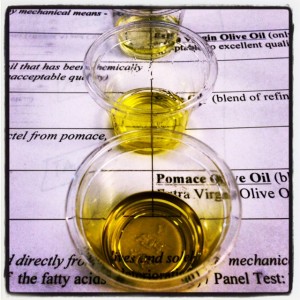Olive oil is not only a cornerstone to the Mediterranean diet, but also a versatile, must-have in the American kitchen and all over the world. No matter where the oil comes from (Spain, Italy, California…), these oils compliment different foods and uses. Yesterday Professor Bosticco clarified some basics that may help you to decide which oil is best for what!
– Simply Virgin does not imply quality, but refers only to how the fat is extracted. Virgin implies no chemical use and no high temperatures – the olives are pressed by machine at room temperature or below.
– Extra Virgin implies the best quality oils you can purchase – oils with this label have passed a chemical test and a taste test (and like virgin, are pressed only by machine and at low temperatures)
– Merely olive oil is usually a blend of chemically adjusted oils that are of unacceptable quality
– Cold-pressed is a marketing tool. Any decent olive oil should be cold pressed but this is implied in virgin and extra virgin oils
– We tried a rancid olive oil, which is really common – you can tell by taste or smell that the oil is over oxidized. Rancidity can be avoided by storing olive oil away from the sun and high temperatures. Also, it is best to use olive oil within six months to a year.
– Uses: Extra virgin is best on already cooked foods, salads, or for dipping bread – when heated, like in a pan, many of the best qualities are destroyed (if you use olive oil for cooking, you can simply use virgin)
– If you aren’t going to use the EVOO quickly, it is best to buy young oil in small quantities, to make the most of your money!
– A good EVOO has the year of production on the label – The younger the olive oil, the fresher it is. It should be green-ish gold in color and smell like grass, hay, nuts, or fruit.
